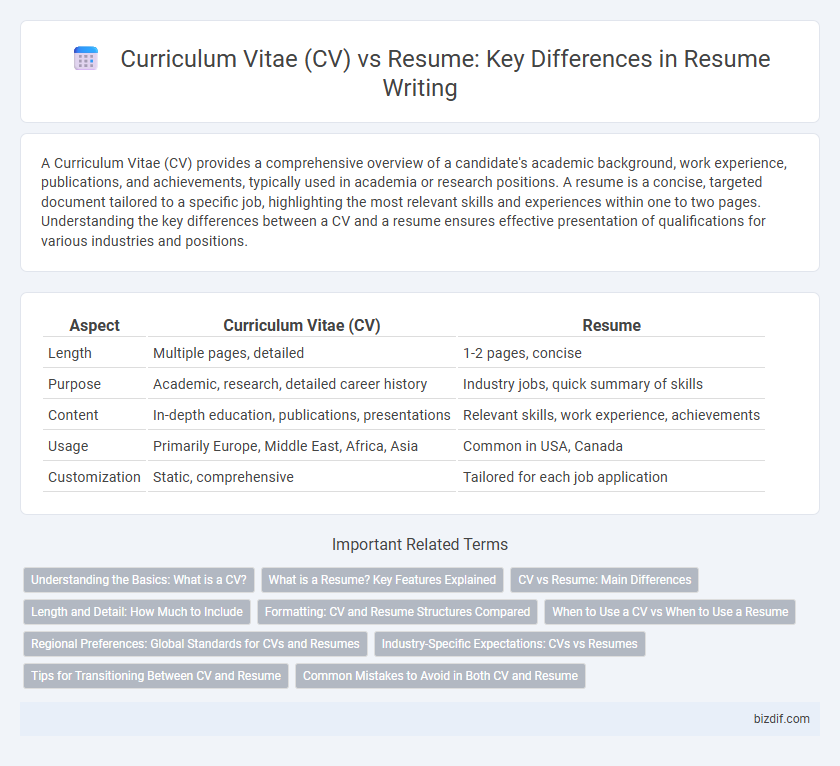A Curriculum Vitae (CV) provides a comprehensive overview of a candidate's academic background, work experience, publications, and achievements, typically used in academia or research positions. A resume is a concise, targeted document tailored to a specific job, highlighting the most relevant skills and experiences within one to two pages. Understanding the key differences between a CV and a resume ensures effective presentation of qualifications for various industries and positions.
Table of Comparison
| Aspect | Curriculum Vitae (CV) | Resume |
|---|---|---|
| Length | Multiple pages, detailed | 1-2 pages, concise |
| Purpose | Academic, research, detailed career history | Industry jobs, quick summary of skills |
| Content | In-depth education, publications, presentations | Relevant skills, work experience, achievements |
| Usage | Primarily Europe, Middle East, Africa, Asia | Common in USA, Canada |
| Customization | Static, comprehensive | Tailored for each job application |
Understanding the Basics: What is a CV?
A Curriculum Vitae (CV) is a comprehensive document detailing an individual's academic background, professional experience, publications, and achievements, typically used in academic, research, and international job applications. Unlike a resume, which is concise and tailored for specific positions, a CV provides an in-depth overview of one's career history without strict length limitations. Understanding the structure and purpose of a CV is crucial for effectively presenting qualifications in fields that require detailed career documentation.
What is a Resume? Key Features Explained
A resume is a concise document highlighting an individual's professional experience, skills, and education tailored for specific job applications. Key features include a clear structure with sections such as contact information, objective or summary, work history, skills, and education. It typically spans one to two pages, emphasizing relevant achievements and quantifiable results to capture the employer's attention quickly.
CV vs Resume: Main Differences
A Curriculum Vitae (CV) offers a detailed overview of academic achievements, work history, publications, and professional accomplishments, often extending beyond two pages. A resume provides a concise, tailored summary of relevant skills and experiences, typically limited to one or two pages for quick employer review. Understanding the CV vs Resume distinction ensures effective presentation suited for academic, international, or corporate job applications.
Length and Detail: How Much to Include
A Curriculum Vitae (CV) typically spans multiple pages, providing an in-depth account of academic achievements, publications, and professional history, making it ideal for research or academic roles. Resumes are concise, usually one to two pages, highlighting key skills and experience tailored to a specific job application. Choosing between a CV and a resume depends on the industry standards and how much detail the employer requires.
Formatting: CV and Resume Structures Compared
Curriculum Vitae (CV) and resumes differ significantly in formatting, with CVs offering a comprehensive, detailed structure covering academic history, publications, and professional accomplishments, typically spanning multiple pages. Resumes prioritize concise, targeted information focused on relevant skills and experiences, usually limited to one or two pages with clear section headings. The structured format of CVs supports academic or research-oriented positions, while resumes use a streamlined layout optimized for quick employer review in corporate settings.
When to Use a CV vs When to Use a Resume
A Curriculum Vitae (CV) is typically used for academic, research, and international job applications where detailed information about education, publications, and professional achievements is required. Resumes are preferred in most corporate, nonprofit, and private sector jobs, emphasizing concise, tailored summaries of skills and work experience. Choosing between a CV and a resume depends largely on the job industry, geographic location, and the amount of relevant detail needed.
Regional Preferences: Global Standards for CVs and Resumes
Curriculum Vitae (CV) is the preferred document in Europe, the Middle East, Africa, and Asia, highlighting detailed academic achievements, publications, and professional experiences suitable for academic and research positions. In contrast, the United States and Canada favor resumes, which are concise, typically one or two pages, emphasizing relevant skills and work history tailored to specific job applications. Understanding these regional preferences ensures globally optimized applications that meet recruiters' expectations and enhance job search success.
Industry-Specific Expectations: CVs vs Resumes
In academic, scientific, and research industries, Curriculum Vitae (CVs) provide comprehensive details of education, publications, and professional achievements, catering to the need for in-depth candidate evaluation. In contrast, business, technology, and creative sectors prioritize concise resumes emphasizing relevant skills, work experience, and measurable accomplishments tailored to specific job roles. Understanding these industry-specific expectations helps professionals choose the appropriate document format to effectively showcase their qualifications.
Tips for Transitioning Between CV and Resume
When transitioning between a Curriculum Vitae (CV) and a resume, tailor the content to suit the purpose: CVs offer comprehensive academic and professional details, while resumes emphasize concise summaries relevant to specific job roles. Highlight key accomplishments and skills prominently to match the format, using bullet points in resumes for clarity and narrative depth in CVs for thoroughness. Ensure consistent formatting and update contact information, focusing on keywords aligned with the job description to enhance applicant tracking system (ATS) compatibility.
Common Mistakes to Avoid in Both CV and Resume
Common mistakes to avoid in both CV and resume include using generic objectives instead of tailored summaries that highlight specific skills relevant to the job. Avoid cluttering the document with irrelevant information or excessive details that obscure key achievements. Ensure consistent formatting and correct grammar to maintain professionalism and readability.
Curriculum Vitae (CV) vs Resume Infographic

 bizdif.com
bizdif.com